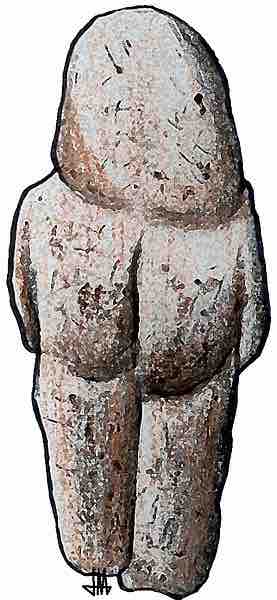The Paleolithic or Old Stone Age originated around 30,000 BCE, lasting until 10,000 BCE, and is separated into three periods: the Lower Paleolithic (the earliest subdivision), Middle Paleolithic, and Upper Paleolithic. The Paleolithic era is characterized by the use of stone tools, although at the time humans also used wood and bone tools. Other organic commodities were adapted for use as tools, including leather and vegetable fibers; however, due to their nature, these have not been preserved to any great degree. Surviving artifacts of the Paleolithic era are known as paleoliths.
Acheulean hand-axes
Acheulean hand-axes from Kent. The types shown are (clockwise from top) cordate, ficron, and ovate. Evidence shows these early hominids intentionally selected raw materials with good flaking qualities and chose appropriate-sized stones for their needs to produce sharp-edged tools for cutting.
The earliest undisputed art originated in the Upper Paleolithic. However, there is some evidence that a preference for aesthetic emerged in the Middle Paleolithic due to the symmetry inherent in discovered artifacts and evidence of attention to detail in such things as tool shape, which has led some archaeologists to interpret these artifacts as early examples of artistic expression. There has been much dispute among scholars over the terming of early prehistoric artifacts as "art." Generally speaking, artifacts dating from the Lower and Middle Paleolithic remain disputed as objects of artistic expression, while the Upper Paleolithic provides the first conclusive examples of art making.
Disputed Art(ifacts): Early Venuses
The Venus of Tan-Tan is an alleged artifact found in Morocco that is believed by some to be the earliest representation of the human form . The Venus, a 2.3 inch long piece of quartzite rock dated between 300,000 and 500,000 years ago during the Middle Paleolithic, was discovered in 1999 in a river terrace deposit on the north bank of the Draa River, just south of the Moroccan village of Tan-Tan. There is controversy among archaeologists as to its nature and origin. Some archaeologists believe it was created by a combination of geological forces as well as tool-based carving. Visible smudge stains have been interpreted by some as remnants of red ochre pigments. For others, the rock's shape is simply the result of natural weathering and erosion, and any human shape is a mere coincidence.

Drawing of the Venus of Tan-Tan
The Venus of Tan-Tan is an alleged artifact found in Morocco that is believed by some to be the earliest representation of the human form.
The Venus of Berekhat Ram is a contemporary of the Venus of Tan-Tan, found at Berekhat Ram on the Golan Heights in 1981. Some believe it to be a representation of a female human figure, dating from the early Middle Paleolithic; however, the claim is highly contested. The object is a red tufic pebble, about 1.4 inches long, which has at least three grooves, possibly incised with a sharp-edged stone tool. The grooves have been interpreted as marking the neck and arms of the figure by some, while others believe these to be purely naturally-occurring lines.
Mask of la Roche-Cotard
Also known as the Mousterian Protofigurine, the Mask of la Roche-Cotard is an artifact from the Paleolithic period that was discovered in the entrance of the La Roche-Cotard cave, situated on the banks of the Loire River in France. Constructed using flint and bone, the stone is believed to represent the upper part of a face, while the bone has been interpreted as eyes. While some archaeologists question whether this artifact does indeed represent a rendered face, it has been occasionally regarded as an example of Paleolithic figurative artistic expression.
Bilzingsleben
Bilzingsleben is a site of early Paleolithic human remains discovered in Thuringia, Germany. The area was also the site of discovery of many stone and bone tools such as hoes, scrapers, points, and gougers. One bone fragment, an elephant tibia, has two groups of incised parallel lines which some have interpreted as an early example of art making. The regular spacing of the incisions, their sub-equal lengths, and V-like cross-sections suggest that they were created at the same time, with a single stone; however, no conclusive agreement has been made.
Blombos Cave
Discoveries of engraved stones in the Blombos Caves of South Africa has led some archaeologists to believe that early Homo sapiens were capable of abstraction and the production of symbolic art. Made from ochre, the stones are engraved with abstract patterns, and while they are simpler than prehistoric cave paintings found in Europe, some scholars believe these engraved stones represent the earliest known artworks, dating from 75,000 years ago. Although, much like the other pieces, this belief remains contested.

Engraved ochre from the Blombos Cave
Engraved ochre from the Blombos Cave has led some historians to believe that early Homo sapiens were capable of symbolic art.